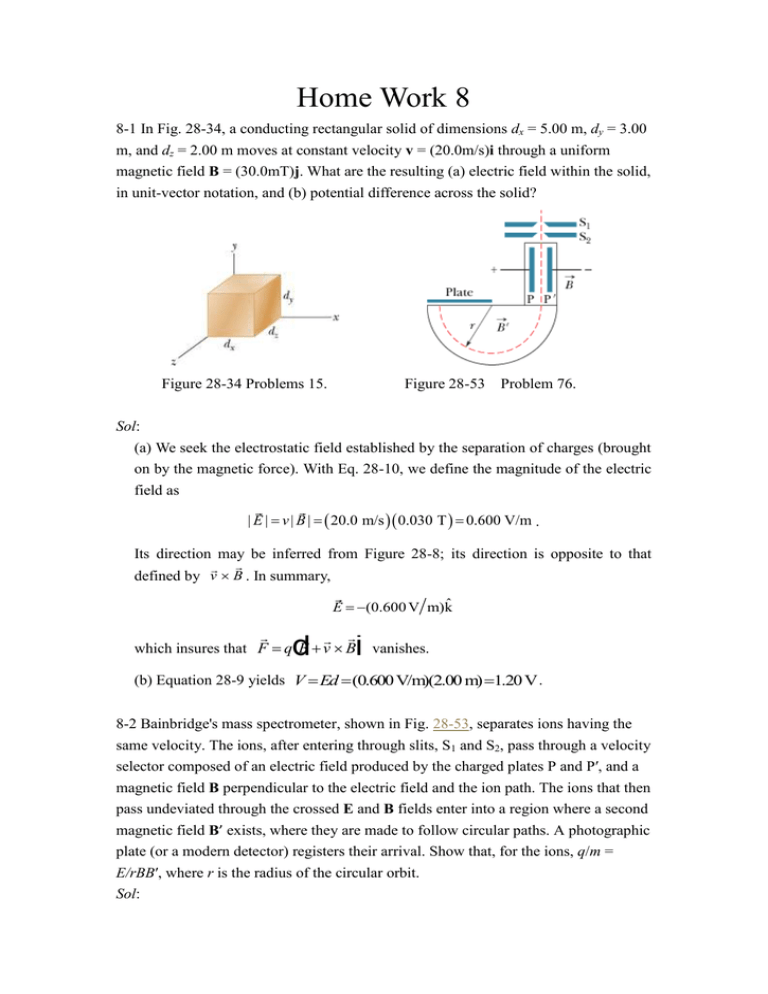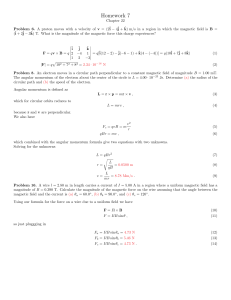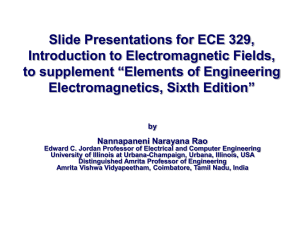Home Work 8
advertisement

Home Work 8 8-1 In Fig. 28-34, a conducting rectangular solid of dimensions dx = 5.00 m, dy = 3.00 m, and dz = 2.00 m moves at constant velocity v = (20.0m/s)i through a uniform magnetic field B = (30.0mT)j. What are the resulting (a) electric field within the solid, in unit-vector notation, and (b) potential difference across the solid? Figure 28-34 Problems 15. Figure 28-53 Problem 76. Sol: (a) We seek the electrostatic field established by the separation of charges (brought on by the magnetic force). With Eq. 28-10, we define the magnitude of the electric field as | E | v | B | 20.0 m/s 0.030 T 0.600 V/m . Its direction may be inferred from Figure 28-8; its direction is opposite to that defined by v B . In summary, E (0.600 V m)kˆ which insures that F q E v B d i vanishes. (b) Equation 28-9 yields V Ed (0.600 V/m)(2.00 m) 1.20 V . 8-2 Bainbridge's mass spectrometer, shown in Fig. 28-53, separates ions having the same velocity. The ions, after entering through slits, S1 and S2, pass through a velocity selector composed of an electric field produced by the charged plates P and P′, and a magnetic field B perpendicular to the electric field and the ion path. The ions that then pass undeviated through the crossed E and B fields enter into a region where a second magnetic field B’ exists, where they are made to follow circular paths. A photographic plate (or a modern detector) registers their arrival. Show that, for the ions, q/m = E/rBB′, where r is the radius of the circular orbit. Sol: Using Eq. 28-16, the charge-to-mass ratio is q v . With the speed of the ion m Br given by v E / B (using Eq. 28-7), the expression becomes q E/B E . m Br BBr 8-3 A 1.0 kg copper rod rests on two horizontal rails 1.0 m apart and carries a current of 50 A from one rail to the other. The coefficient of static friction between rod and rails is 0.60. What are the (a) magnitude and (b) angle (relative to the vertical) of the smallest magnetic field that puts the rod on the verge of sliding? Sol: (a) The magnetic force must push horizontally on the rod to overcome the force of friction, but it can be oriented so that it also pulls up on the rod and thereby reduces both the normal force and the force of friction. The forces acting on the rod are: F, the force of the magnetic field; mg, the magnitude of the (downward) force of gravity; FN , the normal force exerted by the stationary rails upward on the rod; and f , the (horizontal) force of friction. For definiteness, we assume the rod is on the verge of moving eastward, which means that f points westward (and is equal to its maximum possible value sFN). Thus, F has an eastward component Fx and an upward component Fy, which can be related to the components of the magnetic field once we assume a direction for the current in the rod. Thus, again for definiteness, we assume the current flows northward. Then, by the right-hand rule, a downward component (Bd) of B will produce the eastward Fx, and a westward component (Bw) will produce the upward Fy. Specifically, Fx iLBd , Fy iLBw . Considering forces along a vertical axis, we find FN mg Fy mg iLBw so that f fs, max s mg iLBw . It is on the verge of motion, so we set the horizontal acceleration to zero: Fx f 0 iLBd s mg iLBw . The angle of the field components is adjustable, and we can minimize with respect to it. Defining the angle by Bw = B sin and Bd = B cos (which means is being measured from a vertical axis) and writing the above expression in these terms, we obtain iLB cos s mg iLB sin B s mg iL cos s sin which we differentiate (with respect to ) and set the result equal to zero. This provides a determination of the angle: tan1 s tan1 0.60 31. Consequently, Bmin 0.60 1.0kg 9.8m s2 50A1.0m cos31 0.60sin 31 0.10T. (b) As shown above, the angle is tan 1 s tan 1 0.60 31. 8-4 A positron with kinetic energy 2.00 keV is projected into a uniform magnetic field B of magnitude 0.100 T, with its velocity vector making an angle of 89.0° with B. Find (a) the period, (b) the pitch p, and (c) the radius r of its helical path. Sol: (a) If v is the speed of the positron then v sin is the component of its velocity in the plane that is perpendicular to the magnetic field. Here is the angle between the velocity and the field (89°). Newton’s second law yields eBv sin = me(v sin )2/r, where r is the radius of the orbit. Thus r = (mev/eB) sin . The period is given by T 2 9.111031 kg 2me 2r 3.581010 s. 19 v sin eB 1.6010 C 0.100T The equation for r is substituted to obtain the second expression for T. (b) The pitch is the distance traveled along the line of the magnetic field in a time interval of one period. Thus p = vT cos . We use the kinetic energy to find the speed: K 21 mev2 means 2 2.00 103 eV 1.60 1019 J eV 2K v 2.65 107 m s . me 9.111031 kg Thus, p 2.65107 m s 3.581010 s cos 89 1.66104 m . (c) The orbit radius is 9.111031 kg 2.65 107 m s sin89 mev sin R 1.51103 m . 19 eB 1.60 10 C 0.100 T 8-5. 27.90.IDENTIFY: The current direction is perpendicular to B, so F IlB. If the liquid doesn’t flow, a force (p) A from the pressure difference must oppose F. SET UP: J I/A, where A hw. EXECUTE: (a) p F/A IlB/A JlB. (b) J EVALUATE: p (100 atm)(1013 105 Pa/atm) 132 106 A/m2 . lB (00350 m)(220 T) A current of 1 A in a wire with diameter 1 mm corresponds to a current density of J 13 106 A/m2 , so the current density calculated in part (c) is a typical value for circuits. 8-6. 27.91.IDENTIFY: The electric and magnetic fields exert forces on the moving charge. The work done by the electric field equals the change in kinetic energy. At the top point, a y v2 and this acceleration R must correspond to the net force. SET UP: The electric field is uniform so the work it does for a displacement y in the y-direction is W Fy qEy. At the top point, FB is in the y-direction and FE is in the y-direction. EXECUTE: (a) The maximum speed occurs at the top of the cycloidal path, and hence the radius of curvature is greatest there. Once the motion is beyond the top, the particle is being slowed by the electric field. As it returns to y 0, the speed decreases, leading to a smaller magnetic force, until the particle stops completely. Then the electric field again provides the acceleration in the y-direction of the particle, leading to the repeated motion. 1 2qEy (b) W qEy mv 2 and v . 2 m (c) At the top, Fy qE qvB EVALUATE: 2E mv 2 m 2qEy . qE. 2qE qvB and v B R 2y m The speed at the top depends on B because B determines the y-displacement and the work done by the electric force depends on the y-displacement.


